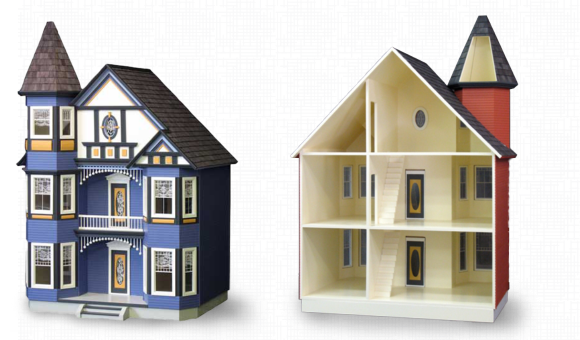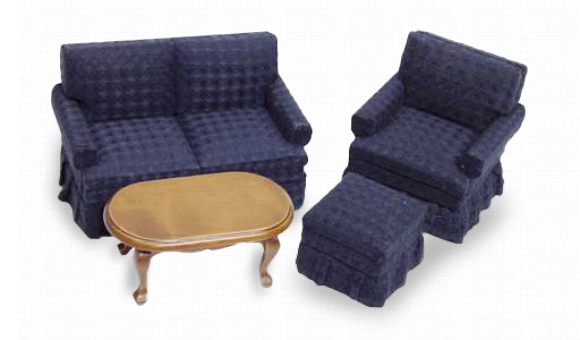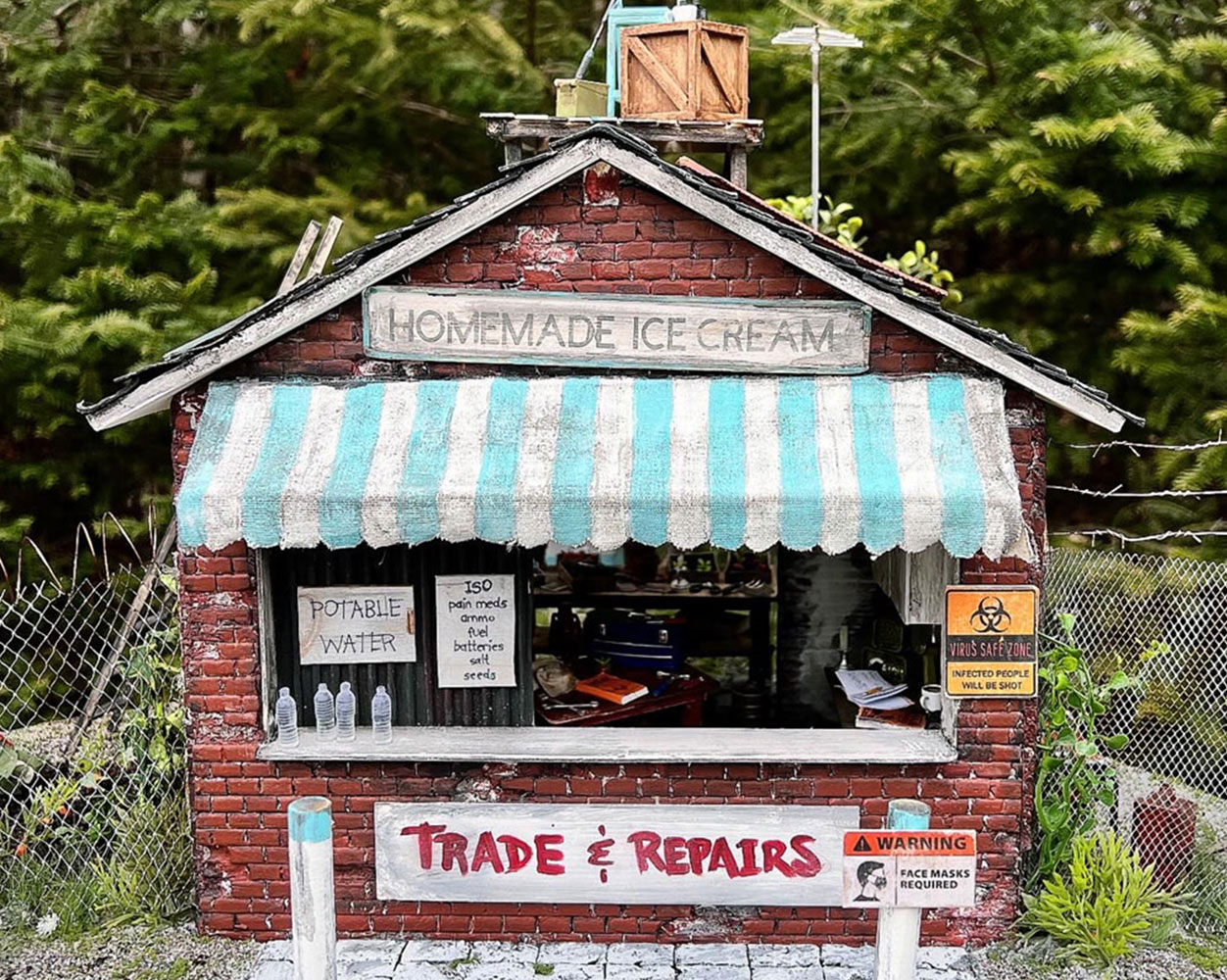The use of bricks can add a touch of class to your dollhouse. As a design element, bricks can be used in a variety of ways, including the exterior walls of your dollhouse, the foundation, walks, streets, patios, chimneys, posts, columns, mailbox holders, flower boxes, around trees and landscaping, doghouses, outhouses, and cellar doors, to name a few. All of these projects may be done with either plastic brick, clay brick or a combination of both.
Plastic Brick
To cut the heavier plastic "Brickmaster" brick sheets:
- Soak the piece of plastic brick in boiling water for about five minutes.
- Place the brick piece on a cutting board. Using an utility knife, score the brick where you intend to cut. I use a utility knife because it is stronger and takes the pressure needed to score the brick. Some people score with the saw that comes with the X-Acto miter set.
- Score the line four or five times.
- Place the piece of brick back into the boiling water for two or three minutes. Remove the brick from the water and, holding each side of the brick piece, bend until it snaps in two.
- Lightly sand the edges smooth.
The plastic brick can be cut on an electric saw with a narrow blade, but be sure it does not get too hot, as it will melt. To bend the brick piece around an arch or Queen Anne turret, leave it in the boiling water longer. Then you can form it around the area you want to cover. For a quicker method, use a hair dryer along the brick corner, and bend it very carefully for the edge of an archway.
The plastic "brickmaster" corners can be used with the "brickmaster" sheets, or with the common clay bricks either on the mesh the individual common bricks. The corners can also be used as brick corners combined with lattice under a porch.
To Make A Brick Column
Snap four pieces of the Corners together to make a column, or cut to desired length to make posts for wrought iron fences.
To cut the brick corners for the posts:
- Use a hair dryer on the area that you want to cut.
- Bend it on the line to break. Be careful, because sometimes it tries to break on the line above or below.
- Sand the edge smooth.
To snap the pieces together, very carefully spread the spaces a little bit by pulling both ends at the same time. Then, push one piece into the other piece until all the bricks fit together. After snapping the two pieces together (which takes patience), I put Quick Grip glue on the inside in order to hold the two pieces together permanently. Repeat for both sides.
Next, snap the two sides together and very carefully put some glue inside. You now have a post!
To finish off the brick posts with the look of cement tops and bottoms, use blocks of wood covered with mortar or spackle. Then paint them the color of cement. To finish the brick, use dollhouse mortar (available from miniature shops), tile grout (available from a hardware store, Builder's Square or Home Depot), or vinyl bathroom caulking to fill in the grooves for the mortar. I usually use my fingers to smooth it on the brick and then remove the excess with a damp cloth. Do not use anything metal, as it will scratch the surface of the brick.
There are sheets of thin plastic brick available in miniature shops that can be cut with scissors. Be sure that the glue you use does not react with the plastic. Test it on a scrap piece first. I use G.E. Silicone Adhesive for applying this type of brick. For a unique look, try antiquing the plastic brick.
Various designs and colors of brick are available in paper sheets. They are applied like wallpaper and are particularly good for kitchen floors and the firebrick inside a fireplace.
Common Clay Bricks
Common Bricks are genuine clay bricks mounted on mesh. Each sheet measures 12" x 6" and covers approximately 72 inches. The ends are notched so that each piece fits into another. You may cut through the mesh to get the size needed for your project. I use small wire cutters to cut the bricks. Cut each brick individually and they will snap in two. They may be used for chimneys, walls, foundations and walks. I use Bond 527 glue to apply the mesh onto the wood. Be very careful if you use Quick Grip glue, because it can ooze out between the bricks and onto the top surface. Once on, it is very difficult to get off and can ruin the finish of the brick.
To determine how much brick you will need, measure the area to be covered. Multiply the length times the width to get the square inches. Sometimes it is easier to make a pattern of the area to be covered. Then you can simply lay the pattern on the bricks (on the mesh side), and cut with the wire cutter.
Patio Bricks are also genuine clay bricks mounted on a mesh backing. They are square shaped and may be used for patios, floors, walks or whatever your imagination decides. The instructions, outlined above, will work for these bricks as well.
Genuine Clay Bricks
Genuine Clay Bricks come in bags of 50 individual loose pieces. These pieces may be used to build chimneys, walks, floors, etc. One bag of 50 bricks will make a 3 1/2" x 5" (17.50" sq.) herringbone floor pattern. It takes seven bags to do a 9" x 12" floor. One bag of 50 bricks will make a 3 1/2" x 4 1/2" (15.75" sq.) straight brick floor.
These individual bricks are also available in the square patio style. The patio bricks and the common bricks may be used together to make a design for a patio or floor.
Cobblestones
Cobblestones for streets and paths are square stones. For this look, I suggest using the patio bricks. You may either use them in the clay color, weathered, or make them look like stone.
These bricks must be glued on individually with spaces left for the mortar. I usually glue the bricks on with Bond 527 and then apply the mortar.
Using a putty knife, pallet knife or your fingers, pick up a small amount of mortar and fill in the crevices and cracks between the bricks. Work one small area at a time. Wipe off the excess mortar with a rag or sponge, rinsing it out often. Wipe until you get the finish and look you want. After the mortar dries, you can seal the brick with an acrylic spray sealer. This gives the brick an aged look, because the mortar seeps into the face of the brick.
For a new brick look, spray the brick with acrylic spray sealer before you start to mortar the brick. This keeps the mortar from seeping into the brick. After applying the mortar, you can spray with an acrylic sealer again.
To give bricks an antique look, use an antiquing medium. I usually use an oil base stain or an antiquing medium that is thicker. I have also used the craft antiquing medium called "Mud." Apply per directions and let set until it is tacky to the touch (about 10 minutes), or as stated in directions. Then take cheesecloth and a dry brush, and wipe off the excess. Leave it darker in the corners and around the windows and doors, as well as in spots on the walls. Use a dry brush to spread and feather so that it looks real.
Brick Chimney
- A wood chimney can be used as the base for the brick chimney.
- If you wish to paint the top, paint it now. Then let dry.
- Plastic or clay bricks may be used.
- Make a pattern of both the front and back of the chimney.
- Cut the pieces of brick to match each pattern. Make sure the lines of brick are even and will match when the sides are applied.
- Glue the bricks on both the front and back of wood chimney with Bond 527 glue.
- Let dry.
- Make a pattern for each side of the chimney, including the extra quarter inch or so that the bricks on the front and back have added to the width on each side.
- Cut the bricks to match each pattern. Be careful to match the alternating sequence of half and whole brick. Keep the lines even!
- Glue on the sides and set aside for 24 hours.
- The next day, apply the mortar as explained for brick.
- Let the mortar dry.
- Glue the chimney onto the house.



